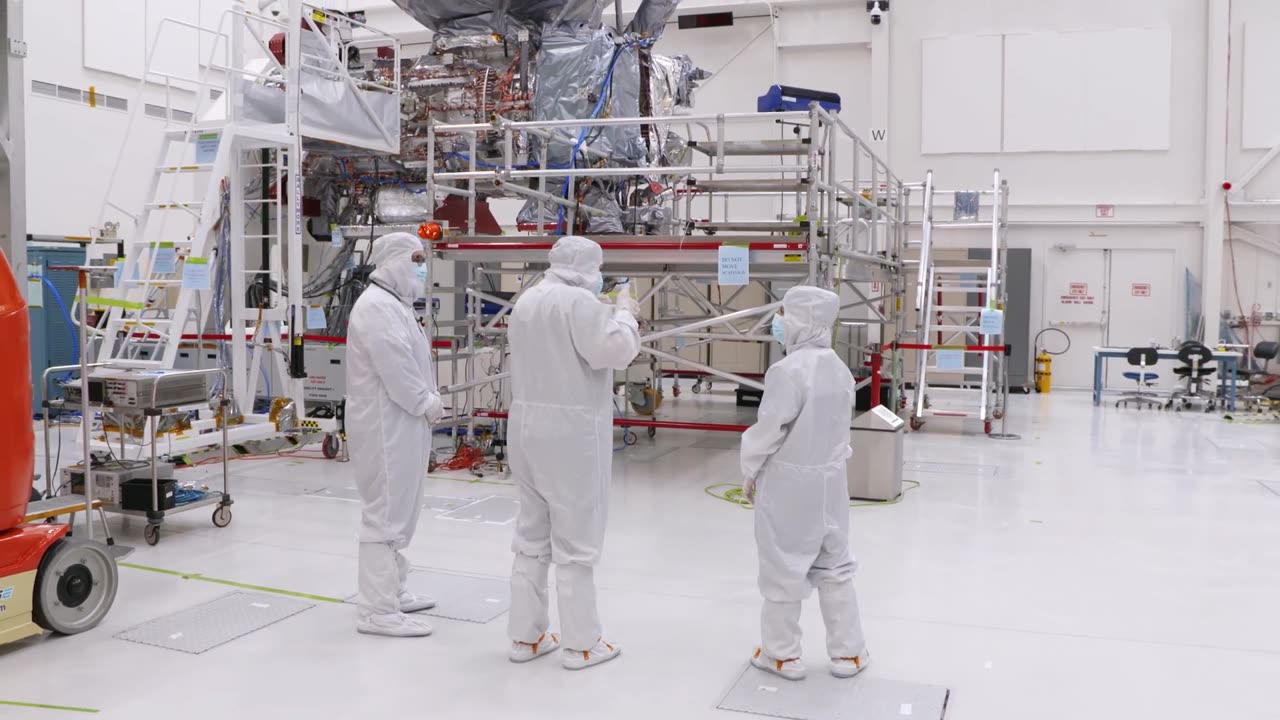Premium Only Content

Spacecraft Makers: Europa Clipper's Instrument Integration
#spacecraft #europaclippers #integration #spaceship #nasa #galaxies #spacerocket #rocket #aircraft #solarsystem #planets #wolfchamp
Spacecraft Makers: Europa Clipper's Instrument Integration
Hardware for NASA’s Europa Clipper spacecraft was developed at various institutions and facilities across the U.S. and Europe, including NASA's Jet Propulsion Laboratory. That work included the science instruments and other spacecraft components, such as the propulsion module, radio frequency module, solar arrays, electronics vault, and more.
During the assembly, test, and launch operations phase of the mission, engineers put together the spacecraft, test its various components, and prepare it for its launch and journey to Jupiter’s ice-encrusted moon Europa.
In this episode of the Spacecraft Makers video series, spacecraft assembly, test, and launch operations mechanical engineer Steve Barajas and science systems engineer Jenny Kampmeier provide a behind-the-scenes look at the nearly completed spacecraft in the High Bay 1 clean room at JPL.
The propulsion module for the spacecraft was built by the Johns Hopkins Applied Physics Laboratory (APL) in Laurel, Maryland, with help from NASA’s Goddard Space Flight Center in Greenbelt, Maryland, and JPL.
The science instruments were developed by APL, the School of Earth and Space Exploration at Arizona State University, Southwest Research Institute in San Antonio, JPL, UCLA, University of Michigan, University of Texas at Austin, and the Laboratory for Atmospheric and Space Physics at the University of Colorado Boulder.
Spacecraft Makers is a video series that takes audiences behind the scenes to learn more about how space missions, like Europa Clipper, come together. Europa Clipper will explore this icy moon of Jupiter to see if there are conditions suitable for life. The spacecraft needs to be hardy enough to survive a 1.6 billion-mile, six-year journey to Jupiter – and sophisticated enough to perform a detailed science investigation of Europa once it arrives at the Jupiter system in 2030.
Europa Clipper is expected to launch in October 2024 from Kennedy Space Center in Florida.
Spacecraft Makers: Europa Clipper's Instrument Integration
Hardware for NASA’s Europa Clipper spacecraft was developed at various institutions and facilities across the U.S. and Europe, including NASA's Jet Propulsion Laboratory. That work included the science instruments and other spacecraft components, such as the propulsion module, radio frequency module, solar arrays, electronics vault, and more.
During the assembly, test, and launch operations phase of the mission, engineers put together the spacecraft, test its various components, and prepare it for its launch and journey to Jupiter’s ice-encrusted moon Europa.
In this episode of the Spacecraft Makers video series, spacecraft assembly, test, and launch operations mechanical engineer Steve Barajas and science systems engineer Jenny Kampmeier provide a behind-the-scenes look at the nearly completed spacecraft in the High Bay 1 clean room at JPL.
The propulsion module for the spacecraft was built by the Johns Hopkins Applied Physics Laboratory (APL) in Laurel, Maryland, with help from NASA’s Goddard Space Flight Center in Greenbelt, Maryland, and JPL.
The science instruments were developed by APL, the School of Earth and Space Exploration at Arizona State University, Southwest Research Institute in San Antonio, JPL, UCLA, University of Michigan, University of Texas at Austin, and the Laboratory for Atmospheric and Space Physics at the University of Colorado Boulder.
Spacecraft Makers is a video series that takes audiences behind the scenes to learn more about how space missions, like Europa Clipper, come together. Europa Clipper will explore this icy moon of Jupiter to see if there are conditions suitable for life. The spacecraft needs to be hardy enough to survive a 1.6 billion-mile, six-year journey to Jupiter – and sophisticated enough to perform a detailed science investigation of Europa once it arrives at the Jupiter system in 2030.
Europa Clipper is expected to launch in October 2024 from Kennedy Space Center in Florida.
Spacecraft Makers: Europa Clipper's Instrument Integration
Hardware for NASA’s Europa Clipper spacecraft was developed at various institutions and facilities across the U.S. and Europe, including NASA's Jet Propulsion Laboratory. That work included the science instruments and other spacecraft components, such as the propulsion module, radio frequency module, solar arrays, electronics vault, and more.
During the assembly, test, and launch operations phase of the mission, engineers put together the spacecraft, test its various components, and prepare it for its launch and journey to Jupiter’s ice-encrusted moon Europa.
In this episode of the Spacecraft Makers video series, spacecraft assembly, test, and launch operations mechanical engineer Steve Barajas and science systems engineer Jenny Kampmeier provide a behind-the-scenes look at the nearly completed spacecraft in the High Bay 1 clean room at JPL.
The propulsion module for the spacecraft was built by the Johns Hopkins Applied Physics Laboratory (APL) in Laurel, Maryland, with help from NASA’s Goddard Space Flight Center in Greenbelt, Maryland, and JPL.
The science instruments were developed by APL, the School of Earth and Space Exploration at Arizona State University, Southwest Research Institute in San Antonio, JPL, UCLA, University of Michigan, University of Texas at Austin, and the Laboratory for Atmospheric and Space Physics at the University of Colorado Boulder.
Spacecraft Makers is a video series that takes audiences behind the scenes to learn more about how space missions, like Europa Clipper, come together. Europa Clipper will explore this icy moon of Jupiter to see if there are conditions suitable for life. The spacecraft needs to be hardy enough to survive a 1.6 billion-mile, six-year journey to Jupiter – and sophisticated enough to perform a detailed science investigation of Europa once it arrives at the Jupiter system in 2030.
Europa Clipper is expected to launch in October 2024 from Kennedy Space Center in Florida.
-
 LIVE
LIVE
Josh Pate's College Football Show
5 hours ago $0.59 earnedCFP Prediction Special: OhioSt vs Oregon | UGA vs Notre Dame | Texas vs ASU | Boise vs PennSt
800 watching -
 LIVE
LIVE
Scottish Viking Gaming
3 hours ago💚Rumble :|: SUNDAY FUNDAY :|: Virginia has two Verginers, Change my Mind!
833 watching -
 1:49:50
1:49:50
Winston Marshall
2 days agoThe DARK Reality of Socialism - Historian Giles Udy
14.1K32 -
 DVR
DVR
Sports Wars
1 hour agoBengals STAY ALIVE In OT Thriller, ESPN's Ryan Clark SLAMMED, NFL DESTROYS NBA On Christmas
8.31K1 -
 9:37
9:37
EvenOut
19 hours ago $1.83 earnedThe Non-Reflecting Mirror Scare Twin Prank!
13.3K1 -
 11:19
11:19
Tundra Tactical
18 hours ago $2.25 earnedI Saw How CMMG Makes Guns.
15.9K6 -
 15:34
15:34
Misha Petrov
14 hours agoReacting To TikTok’s Most DELUSIONAL Takes!
18.1K17 -
 1:52:24
1:52:24
Squaring The Circle, A Randall Carlson Podcast
1 day ago#032 Flournoy Holmes' Artwork Helped Define The Southern Rock Phenomenon of The Early 1970's
15.6K3 -
 19:56
19:56
inspirePlay
1 day ago $0.21 earnedWalking with Lions & Facing Africa’s Wild Side | Safari Adventure with the Grid Championship Crew!
8.97K -
 10:50
10:50
RTT: Guns & Gear
1 day ago $0.72 earnedBudget Friendly Carry 2011: EAA Girsan Brat 2311
10.6K3